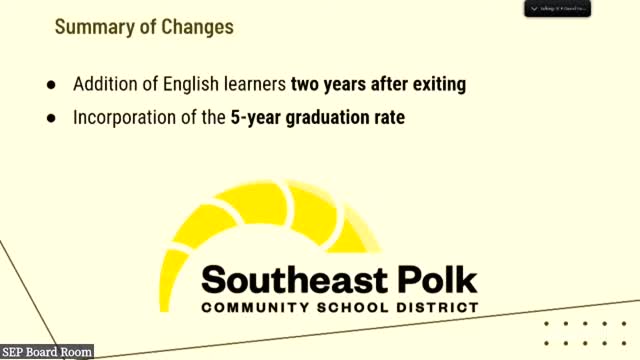Iowa schools overhaul achievement scoring system for fairness
October 18, 2024 | Southeast Polk Comm School District, School Districts, Iowa
This article was created by AI summarizing key points discussed. AI makes mistakes, so for full details and context, please refer to the video of the full meeting. Please report any errors so we can fix them. Report an error »

In a recent government meeting, significant changes to the evaluation metrics for schools were discussed, focusing on how student performance and attendance will be assessed moving forward. One of the key updates involves the treatment of English learners; previously, these students were included in overall achievement scores immediately upon exiting the program. Now, there will be a two-year grace period post-exit, allowing students to solidify their language skills before being factored into the overall scores.
The meeting also highlighted the reinstatement of both four-year and five-year graduation rates in response to feedback from educators concerned about adequately representing all students, particularly those in specialized programs. Additionally, science assessments will now be included alongside English language arts and math, with evaluations occurring at grades 5, 8, and 10.
A notable shift in the evaluation process is the introduction of a chronic absenteeism indicator, which will replace the previous conditions for learning survey. This new metric will utilize attendance rates to gauge school climate and culture, reflecting a more direct measure of student engagement.
Changes to post-secondary readiness indicators were also announced, with new metrics including the percentage of students participating in work-based learning and those earning college credits while still in high school. A phased implementation will begin in 2024 for the inclusion of industry-recognized certifications.
The scoring system is set to undergo a simplification, moving from a complex statistical analysis to a straightforward 100-point scale. This change aims to provide clearer expectations for schools regarding their performance scores.
Furthermore, the meeting addressed adjustments in how participation rates affect school rankings. Schools that fail to meet participation thresholds will see a decrease in their performance category, emphasizing the importance of student engagement in evaluations.
Overall, these changes are designed to create a more equitable and transparent assessment framework for schools, with a focus on both proficiency and growth in student performance. The new performance profiles are expected to be released between Thanksgiving and Christmas, providing schools with a fresh start under the updated metrics.
The meeting also highlighted the reinstatement of both four-year and five-year graduation rates in response to feedback from educators concerned about adequately representing all students, particularly those in specialized programs. Additionally, science assessments will now be included alongside English language arts and math, with evaluations occurring at grades 5, 8, and 10.
A notable shift in the evaluation process is the introduction of a chronic absenteeism indicator, which will replace the previous conditions for learning survey. This new metric will utilize attendance rates to gauge school climate and culture, reflecting a more direct measure of student engagement.
Changes to post-secondary readiness indicators were also announced, with new metrics including the percentage of students participating in work-based learning and those earning college credits while still in high school. A phased implementation will begin in 2024 for the inclusion of industry-recognized certifications.
The scoring system is set to undergo a simplification, moving from a complex statistical analysis to a straightforward 100-point scale. This change aims to provide clearer expectations for schools regarding their performance scores.
Furthermore, the meeting addressed adjustments in how participation rates affect school rankings. Schools that fail to meet participation thresholds will see a decrease in their performance category, emphasizing the importance of student engagement in evaluations.
Overall, these changes are designed to create a more equitable and transparent assessment framework for schools, with a focus on both proficiency and growth in student performance. The new performance profiles are expected to be released between Thanksgiving and Christmas, providing schools with a fresh start under the updated metrics.
View full meeting
This article is based on a recent meeting—watch the full video and explore the complete transcript for deeper insights into the discussion.
View full meeting
